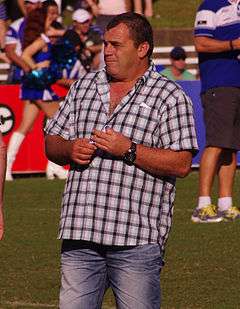David Gillespie
 | ||||||
| David Gillespie in February 2012 | ||||||
| Personal information | ||||||
|---|---|---|---|---|---|---|
| Nickname | Cement | |||||
| Born | 22 March 1964 Narromine, New South Wales, Australia | |||||
| Playing information | ||||||
| Height | 180 cm (5 ft 11 in) | |||||
| Weight | 95 kg (14 st 13 lb; 209 lb) | |||||
| Position | Prop, Second-row | |||||
| Club | ||||||
| Years | Team | Pld | T | G | FG | P |
| 1984–90 | Canterbury-Bankstown | 115 | 13 | 0 | 0 | 52 |
| 1987–88 | Hunslet | |||||
| 1991–93 | Western Suburbs | 46 | 3 | 0 | 0 | 12 |
| 1994–97 | Manly-Warringah | 92 | 1 | 0 | 0 | 4 |
| Total | 253 | 17 | 0 | 0 | 68 | |
| Representative | ||||||
| Years | Team | Pld | T | G | FG | P |
| 1986–94 | New South Wales | 15 | 0 | 0 | 0 | 0 |
| 1988–95 | Australia | 16 | 3 | 0 | 0 | 12 |
| Source: RLP, Yesterday's Hero | ||||||
David "Cement" Gillespie (born 22 March 1964) is an Australian former professional rugby league footballer of the 1980s and 90s. An all-time great defender with a devastating tackling technique, Gillespie played in the Second-row and Prop forward positions for the Canterbury-Bankstown Bulldogs, Western Suburbs Magpies, Manly-Warringah Sea Eagles, New South Wales and for the Australian national side. He is currently a defensive coach for both the Roosters and the Sharks, being a close friend of Ricky Stuart.
Playing career
Born in Narromine, New South Wales, Gillespie joined Sydney club Canterbury-Bankstown in 1982 after being signed by former international Tim Pickup whilst playing for New South Wales U/17's in a State of Origin curtain raiser game against Queensland at Lang Park. Pickup was there on behalf of the Bulldogs to sign another player, yet came away with Gillespie's signature as his defensive prowess could not be denied. He spent time in the lower grades honing his skills and absorbing the Canterbury culture, becoming a fringe first grader and occasional starter in the 1984 season, where his powerful tackling earned him the well-known nickname "Cement". His defence was critical to Canterbury's retention of the title against a heavily favoured St. George side in 1985, the Bulldogs winning the Grand Final 7-6 with Gillespie coming off the bench after having scored a rare try in their powerful 26-nil win over Parramatta in the preliminary final.
The following year Gillespie was chosen play for New South Wales as a replacement in the opening State of Origin. He was favoured to tour England and France with the Kangaroos before severing his index finger in a horrible work accident, which ended his season on the eve of the 1986 finals, where the Bulldogs would eventually lose to Parramatta in the infamous 4-2 Grand Final.[1]
1987 saw two suspensions (in one of which he was, unusually, sent off on the first tackle of a match against Balmain) rob Gillespie of over a third of his season. He played for English side Hunslet during the 1987–88 Rugby Football League season.[2] Returning to Australia "Cement" came back stronger in 1988 and capped of a terrific season by scoring a try in Canterbury's 24-12 Grand Final victory over Balmain and was subsequently chosen for Australia in the World Cup final against New Zealand.
1989 was a tumultuous season for the Bulldogs as the club failed to make the finals, resulting in a coaching change from outgoing Phil Gould to incoming Chris Anderson, and for Gillespie as he was briefly relegated to reserve grade before a four-week suspension for a dangerous tackle effectively ended his season.
In 1990 Gillespie finally established himself as a regular representative player with powerful displays for New South Wales and in the Test against France in Parkes. At the end of the 1990 NSWRL season, he went on the 1990 Kangaroo tour of Great Britain and France and played in three more tests on tour. He placed himself in the controversial draft and was chosen by Western Suburbs, where he was re-united with former Bulldogs Coach Warren Ryan who was now in charge of the Magpies. Now a mainstay in the National side, Gillespie's high work rate was a vital part of two big wins against New Zealand in 1991 and against Great Britain during the 1992 Great Britain Lions tour of Australia and New Zealand, helping Australia retain The Ashes – though he was criticised at times for not being so committed at club level.
1993 saw Gillespie fall out with Warren Ryan and signed with Manly for 1994 to play with Manly and Australian Coach Bob Fulton. However, the quicker 10-metre rule made his play – based on workrate – less effective and he lost in place in the NSW team after one match.
In 1995 Gillespie was an integral part of a Manly team that threatened to march through the season undefeated, the Sea Eagles fell agonisingly close losing only twice including that years Grand Final 17-4 to his former club Canterbury-Bankstown. He would play for Australia for the final time against New Zealand that season. Gillespie would taste premiership success for the final time when he played in Manly's 20-8 1996 Grand Final win over St.George and would retire the following season after Manly's heartbreaking last second 22-16 loss to Newcastle in the isolated 1997 ARL Grand Final.
References
- ↑ Tait, Paul (1 September 1986). "Gillespie's injury the talking point at Belmore". The Sydney Morning Herald. Fairfax Digital. p. 40. Retrieved 2009-10-07.
- ↑ "Veivers stars in fightback". The Sydney Morning Herald. 30 December 1987. p. 35. Retrieved 2009-10-06.